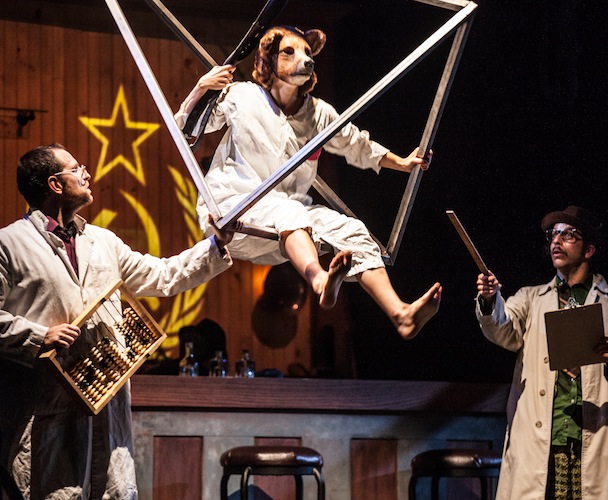Theater Review: “The Grand Parade” — History as an Imaginative Pageant
The Grand Parade is a truly sumptuous feast of imagination, color, emotion and movement; a uniquely dramatic way of interpreting our history as a torrent of events presented without judgment.
The Grand Parade (of the 20th Century), an ensemble work created by Double Edge Theatre. Directed by Stacy Klein. Presented by Arts Emerson at the Paramount Theatre, Boston, MA, through May 3.

Laika, the Space Dog (Milena Dabova and Adam Bright) in “The Grand Parade.” Photo: Maria Baranova.
By Terry Byrne
A girl on a swing, a few of the Marx Brothers, Einstein working at his equations, an ebullient Amelia Earhart, Jacqueline Kennedy in a somber black suit and sunglasses – the imagery generated by Double Edge Theatre’s The Grand Parade (of the 20th Century) assaults our senses. Taking their inspiration from the paintings of Marc Chagall, the ensemble of only nine performers pushes at the boundaries of the Paramount Theatre stage.
The Ashfield-based company, best known for the sprawling summer spectacles that unfold inside and throughout the grounds of their farm, are in no way limited by the Paramount’s traditional proscenium space. The stage is dominated by a huge tent, with a floating human-sized triangle on one side, a dangling human-sized cube on the other, and a swing downstage. Projections of Marc Chagall’s paintings occasionally appear on the white tent, but that is simply a reminder of the painter’s inspiration and an entryway into the world of imagination where several scenes are happening at once.
This production, conceived, designed and directed by Stacy Klein, uses circus tricks, dance, acrobatics, projections and the haunting original music of Alexander Bakshi, to bear witness to the entire 20th century as it tumbles past us in one brief hour. With The Grand Parade, Double Edge taps into emotional and historical memory, vivid colors and potent tableaus, chronicling decades filled with extraordinary technological advances and devastating destruction.
What is most striking about this production is its sense of fluidity. Transitions from Charleston dancers to Nazi occupation, from The Honeymooners TV characters to dancers doing “The Hustle” are all created without pause, reflecting the kaleidoscopic sense of joy and horror captured within Chagall’s paintings. While recurring themes of war and inhumanity appear, there are also lighthearted scenes of humor and triumph. The company’s impressive athleticism enables them to fly, run, leap, and swing from one dramatic event to the next. And although the six primary performers – Carlos Uriona, Matthew Glassman, Hayley Brown, Jeremy Louise Eaton, Adam Bright, and Milena Dabova, along with Jennifer Johnson, Carroll Durand, and Ashley James – are constantly changing costumes for the characters they portray, the changes are rarely visible, and when they were, it makes a thematic point.
In the midst of iconic historic imagery are some unexpectedly poignant moments, including the amusing appearance of Laika the Soviet space dog, who happily scampers around before heading into the space capsule that sent her into orbit. It’s only when she stops moving inside the triangle representing her ship that we realize she was never meant to return to earth.
No words are spoken by the performers in The Grand Parade. The only dialogue we hear is from documentary recordings of specific historic and pop culture moments, such as Herbert Hoover justifying the bank failures, news snippets announcing the deaths of John F. Kennedy and Martin Luther King, Jr., an educational program on “drop and cover” (how to protect yourself in the event of an atomic bomb), and 1950s TV shows. What is striking about this approach is how easy it is to let our imaginations follow the flow, helped by Bakshi’s music, the musical accompaniment (and eerie vocalizing) of Brian Farley on piano and percussion, Walken Schweigert on violin, Amanda Miller on saxophone, and John Peitso on trumpet and percussion.
The Grand Parade is a truly sumptuous feast of imagination, color, emotion and movement; a uniquely dramatic way of interpreting our history as a torrent of events presented without judgment, but offered as an opportunity to shape our future.
Terry Byrne has been writing about the arts for nearly two decades. She has an MFA in Playwriting from Boston University and is a Resident Scholar at Brandeis University’s Women’s Studies Research Center.
